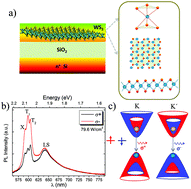Our official English website, www.x-mol.net, welcomes your feedback! (Note: you will need to create a separate account there.)
Revealing the nature of low-temperature photoluminescence peaks by laser treatment in van der Waals epitaxially grown WS2 monolayers†
Nanoscale ( IF 6.7 ) Pub Date : 2018-02-19 00:00:00 , DOI: 10.1039/c8nr00719e V. Orsi Gordo 1, 2, 3, 4, 5 , M. A. G. Balanta 1, 2, 3, 4, 6 , Y. Galvão Gobato 1, 2, 3, 4 , F. S. Covre 1, 2, 3, 4 , H. V. A. Galeti 2, 3, 4, 7 , F. Iikawa 4, 5, 8, 9 , O. D. D. Couto 4, 5, 8, 9 , F. Qu 4, 10, 11, 12 , M. Henini 13, 14, 15, 16, 17 , D. W. Hewak 16, 18, 19, 20 , C. C. Huang 16, 18, 19, 20
Nanoscale ( IF 6.7 ) Pub Date : 2018-02-19 00:00:00 , DOI: 10.1039/c8nr00719e V. Orsi Gordo 1, 2, 3, 4, 5 , M. A. G. Balanta 1, 2, 3, 4, 6 , Y. Galvão Gobato 1, 2, 3, 4 , F. S. Covre 1, 2, 3, 4 , H. V. A. Galeti 2, 3, 4, 7 , F. Iikawa 4, 5, 8, 9 , O. D. D. Couto 4, 5, 8, 9 , F. Qu 4, 10, 11, 12 , M. Henini 13, 14, 15, 16, 17 , D. W. Hewak 16, 18, 19, 20 , C. C. Huang 16, 18, 19, 20
Affiliation

|
Monolayers of transition metal dichalcogenides (TMD) are promising materials for optoelectronics devices. However, one of the challenges is to fabricate large-scale growth of high quality TMD monolayers with the desired properties in order to expand their use in potential applications. Here, we demonstrate large-scale tungsten disulfide (WS2) monolayers grown by van der Waals Epitaxy (VdWE). We show that, in addition to the large structural uniformity and homogeneity of these samples, their optical properties are very sensitive to laser irradiation. We observe a time instability in the photoluminescence (PL) emission at low temperatures in the scale of seconds to minutes. Interestingly, this change of the PL spectra with time, which is due to laser induced carrier doping, is employed to successfully distinguish the emission of two negatively charged bright excitons. Furthermore, we also detect blinking sharp bound exciton emissions which are usually attractive for single photon sources. Our findings contribute to a deeper understanding of this complex carrier dynamics induced by laser irradiation which is very important for future optoelectronic devices based on large scale TMD monolayers.
中文翻译:

在外延生长的WS 2单层中通过激光处理揭示低温光致发光峰的性质†
过渡金属二硫化碳(TMD)的单层是光电子器件的有前途的材料。但是,挑战之一是要大规模生产具有所需性能的高质量TMD单层,以扩大其在潜在应用中的用途。在这里,我们演示了大规模的二硫化钨(WS 2)由范德华磊晶(VdWE)生长的单层膜。我们显示,除了这些样品的大结构均匀性和均一性外,它们的光学特性对激光辐照非常敏感。我们观察到低温下光致发光(PL)发射的时间不稳定性,范围为几秒到几分钟。有趣的是,由于激光诱导的载流子掺杂,PL光谱随时间的变化被成功地用来区分两种带负电的明亮激子的发射。此外,我们还检测到闪烁的激元激子发射,这通常对单光子源很有吸引力。
更新日期:2018-02-19
中文翻译:

在外延生长的WS 2单层中通过激光处理揭示低温光致发光峰的性质†
过渡金属二硫化碳(TMD)的单层是光电子器件的有前途的材料。但是,挑战之一是要大规模生产具有所需性能的高质量TMD单层,以扩大其在潜在应用中的用途。在这里,我们演示了大规模的二硫化钨(WS 2)由范德华磊晶(VdWE)生长的单层膜。我们显示,除了这些样品的大结构均匀性和均一性外,它们的光学特性对激光辐照非常敏感。我们观察到低温下光致发光(PL)发射的时间不稳定性,范围为几秒到几分钟。有趣的是,由于激光诱导的载流子掺杂,PL光谱随时间的变化被成功地用来区分两种带负电的明亮激子的发射。此外,我们还检测到闪烁的激元激子发射,这通常对单光子源很有吸引力。

























 京公网安备 11010802027423号
京公网安备 11010802027423号